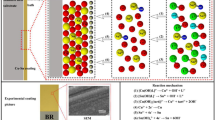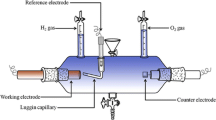Abstract
This work focuses on the investigation of the electrochemical behavior of Sn–Bi plating bath modified by two electrolyte additives, hydroquinone (HQ) and gelatin. Electrochemical studies were carried out by low sweep rate polarization scans, as well as cyclic voltammetry at different scan rates (1–40 mV/s). Polarization scans at sweep rate of 1 mV/s indicate that Bi deposits at about −25 to −45 mV while Sn deposits at about −410 to −420 mV in the plating bath without additives or with either one of the additives. The addition of HQ suppresses hydrogen evolution to more electronegative potentials, showing its adsorption capabilities. On the other hand, gelatin shifts the deposition potential of Bi and is suggested to have a mild complexing effect with Bi ions. The synergistic effect of both HQ and gelatin reduces the potential gap between Bi and Sn from 429 to 255 mV. Investigations on single metallic Sn and Bi plating baths at varying sweep rates reveal different behavior of Sn and Bi ions. The shifting and broadening of Bi cathodic peak potential upon HQ + gelatin addition suggest the formation of HQ–gelatin complex species. Surface morphology and composition analyses were conducted on electrodeposits from each plating bath. Near-eutectic Sn–Bi alloy was successfully electrodeposited from the plating bath modified by HQ + gelatin.








Similar content being viewed by others
References
Briggs E (2011) Advantages of bismuth-based alloys for low temperature Pb-free soldering and rework. In: International conference on soldering & reliability, surface mount technology association (SMTA), Toronto
He H, Xu G, Guo F (2010) Electromigration-induced Bi-rich whisker growth in Cu/Sn–58Bi/Cu solder joints. J Mater Sci 45:334. doi:10.1007/s10853-009-3939-0
Lee Y-G, Park J-G, Lee C-W, Jung J-P (2011) Electrodeposition of the Sn-58 wt%Bi layer for low-temperature soldering. Met Mater Int 17:117. doi:10.1007/s12540-011-0216-y
Wang J, Liu HS, Liu LB, Jin ZP (2006) Interfacial reaction between Sn-Bi alloy and Ni substrate. J Electron Mater 35:1842. doi:10.1007/s11664-006-0166-1
Yoon JW, Lee CB, Jung SB (2002) Interfacial reactions between Sn-58 mass% Bi eutectic solder and (Cu, electroless Ni-P/Cu) substrate. Mater Trans 43:1821
Brenner A (1963) Electrodeposition of alloys: principles and practice. Academic Press, New York
Schlesinger M, Paunovic M (2010) Modern electroplating. Wiley, Hoboken
Goh Y, Haseeb ASMA, Sabri MFM (2013) Effects of hydroquinone and gelatin on the electrodeposition of Sn-Bi low temperature Pb-free solder. Electrochim Acta 90:265. doi:10.1016/j.electacta.2012.12.036
Suh M-S, Park C-J, Kwon H-S (2006) Effects of plating parameters on alloy composition and microstructure of Sn–Bi electrodeposits from methane sulphonate bath. Surf Coat Technol 200:3527. doi:10.1016/j.surfcoat.2004.08.162
Tsai Y-D, Hu C-C, Lin C-C (2007) Electrodeposition of Sn–Bi lead-free solders: Effects of complex agents on the composition, adhesion, and dendrite formation. Electrochim Acta 53:2040. doi:10.1016/j.electacta.2007.09.002
Tsai Y-D, Hu C-C (2009) Composition control of Sn–Bi deposits: interactive effects of citric acid, ethylenediaminetetraacetic acid, and poly(ethylene glycol). J Electrochem Soc 156:D490. doi:10.1149/1.3224861
Tsai Y-D, Lien C-H, Hu C-C (2011) Effects of polyethylene glycol and gelatin on the crystal size, morphology, and Sn2+-sensing ability of bismuth deposits. Electrochim Acta 56:7615. doi:10.1016/j.electacta.2011.06.077
Fukuda M, Imayoshi K, Matsumoto Y (2001) Effect of polyoxyethylenelaurylether on electrodeposition of Pb-free Sn-Bi alloy. Electrochim Acta 47:459
Goh Y, Haseeb A, Liew HL, Sabri MFM (2015) Deformation and fracture behaviour of electroplated Sn–Bi/Cu solder joints. J Mater Sci 50:4258. doi:10.1007/s10853-015-8978-0
Vuković M, Pesic B, Štrbac N, Mihajlović I, Sokić M (2012) Linear polarization study of the corrosion of iron in the presence of Thiobacillus ferrooxidans bacteria. Int J Electrochem Sci 7:2487
Neveu B, Lallemand F, Poupon G, Mekhalif Z (2006) Electrodeposition of Pb-free Sn alloys in pulsed current. Appl Surf Sci 252:3561. doi:10.1016/j.apsusc.2005.05.024
Phong N, Tuyet N, Linh D et al (2006) An application of electrochemical method for studying nano-composite plating. Met Mater Int 12:493. doi:10.1007/bf03027749
Low CTJ, Walsh FC (2008) The stability of an acidic tin methanesulfonate electrolyte in the presence of a hydroquinone antioxidant. Electrochim Acta 53:5280. doi:10.1016/j.electacta.2008.01.093
Fukuda M, Imayoshi K, Matsumoto Y (2002) Effects of thiourea and polyoxyethylene lauryl ether on electrodeposition of Sn-Ag-Cu alloy as a Pb-free solder. J Electrochem Soc 149:C244. doi:10.1149/1.1463404
Joseph S, Phatak GJ (2008) Effect of surfactant on the bath stability and electrodeposition of Sn–Ag–Cu films. Surf Coat Technol 202:3023. doi:10.1016/j.surfcoat.2007.11.002
Wei G, Ge H, Zhu X, Wu Q, Yu J, Wang B (2007) Effect of organic additives on characterization of electrodeposited Co-W thin films. Appl Surf Sci 253:7461. doi:10.1016/j.apsusc.2007.03.045
Hou P, D-x Han L, Niu H-b Lin (2006) Electrochemistry of hydroquinone derivatives at metal and iodine-modified metal electrodes. Chem Res Chin Univ 22:493. doi:10.1016/S1005-9040(06)60149-9
Soriaga MP, White JH, Song D, Hubbard AT (1984) Adsorption and orientation of aromatic compounds at smooth polycrystalline platinum electrodes: the effect of halide electrolytes. J Electroanal Chem Interfacial Electrochem 171:359. doi:10.1016/0022-0728(84)80128-X
Brown GM, Hope GA (1995) SERS study of the adsorption of gelatin at a copper electrode in sulfuric-acid-solution. J Electroanal Chem 397:293
Meudre C, Ricq L, Hihn J-Y, Moutarlier V, Monnin A, Heintz O (2014) Adsorption of gelatin during electrodeposition of copper and tin–copper alloys from acid sulfate electrolyte. Surf Coat Technol 252:93. doi:10.1016/j.surfcoat.2014.04.050
Stavila V, Davidovich RL, Gulea A, Whitmire KH (2006) Bismuth (III) complexes with aminopolycarboxylate and polyaminopolycarboxylate ligands: chemistry and structure. Coord Chem Rev 250:2782. doi:10.1016/j.ccr.2006.02.032
Fischer G (2012) Stabilizers for photographic silver halide emulsions: progress in chemistry and application. Springer, Berlin
Jeong L, Park WH (2014) Preparation and characterization of gelatin nanofibers containing silver nanoparticles. Int J Mol Sci 15:6857
Król-Gracz A, Nowak P, Michalak E, Dyonizy A (2012) Hydro-quinone synthesis of silver nanoparticles from silver bromide suspensions. Acta Physica Polonica-Ser A Gener Phys 121:196
IARC Monographs on the Evaluation of Carcinogenic Risks to Humans, Suppl. 7, overall evaluations of carcinogenicity: an updating of IARC monographs (1987), Lyon
Ishikawa T (2010) Guanidine chemistry. Chem Pharm Bull 58:1555
Zhao G, Li M, Hu Z, Li H, Cao T (2006) Electrocatalytic redox of hydroquinone by two forms of l-proline. J Mol Catal A: Chem 255:86. doi:10.1016/j.molcata.2006.03.039
Yang K, Mahmoudian MR, Ebadi M, Koay H, Basirun W (2011) Diffusion coefficient of Tin(II) methanesulfonate in ionic liquid and methane sulfonic acid (MSA) solvent. Metall Mater Trans B 42:1274. doi:10.1007/s11663-011-9560-z
Goh Y, Lee SF, Haseeb ASMA (2013) Formation of Sn-Bi solder alloys by sequential electrodeposition and reflow. J Mater Sci-Mater Electron 24:2052. doi:10.1007/s10854-012-1055-4
Raub E, Müller K (1967) Fundamentals of metal deposition. Elsevier, Spain
Park W, Hong H-G (2006) Determination of reorganization energy from the temperature dependence of electron transfer rate constant for hydroquinone-tethered self-assembled monolayers (SAMs). Bull Korean Chem Soc 27:381
March G, Reisberg S, Piro B et al (2008) Electrochemical kinetic analysis of a 1,4-hydroxynaphthoquinone self-assembled monolayer. J Electroanal Chem 622:37. doi:10.1016/j.jelechem.2008.04.030
Desic Maja N, Popovic Milica M, Obradovic Maja D, Vracar Ljiljana M, Grgur BN (2005) Study of gold-platinum and platinum-gold surface modification and its influence on hydrogen evolution and oxygen reduction. J Serb Chem Soc 70:231
Zafar A, Melendez R, Geib SJ, Hamilton AD (2002) Hydrogen bond controlled aggregation of guanidinium-carboxylate derivatives in the solid state. Tetrahedron 58:683
Acknowledgements
This research is financially supported by the University of Malaya High Impact Research Grant (HIRG) No. UM.C/HIR/MOHE/ENG/26 (D000026-16001). The authors gratefully acknowledge the helpful discussions with Prof. Jean-Pierre Celis (Department of Materials Engineering, KU Leuven Belgium).
Author information
Authors and Affiliations
Corresponding authors
Rights and permissions
About this article
Cite this article
Goh, Y., Haseeb, A.S.M.A. Studies on electrodeposition behavior of Sn–Bi alloys in plating baths modified by hydroquinone and gelatin. J Mater Sci 51, 5823–5833 (2016). https://doi.org/10.1007/s10853-016-9883-x
Received:
Accepted:
Published:
Issue Date:
DOI: https://doi.org/10.1007/s10853-016-9883-x




